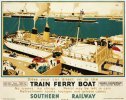By chance, we did a family holiday to Ostend in 1962, and other times. It was always spelled as such then (and before).
My father was in business partnership with a principal organiser of these holidays there, by rail/sea, whose son (teenage then) has written lengthy articles about it all
http://www.youluckypeople.com/you-lucky-people---the-story/falling-in-love4764365 . He's a local and spells it as such too. So that's my opening credentials for this one.
The Dover-Ostend ship was a huge high frequency operation and even beat Dover-Calais/Boulogne for numbers of passengers. The Dunkirk (another name change) ship operation was trivia in comparison. It was operated wholly by a Belgian government company, with no UK participation. Where BR was still building steamships into the mid-1960s, the Belgians had changed over to diesels in the mid-1930s. Partly due to the specific length of the route, about 4 hours at full speed. Two hours to turn round, go back, and such a capable ship could make two regular round trips, day after day, in summer, which was a great efficiency. By 1962 the fleet was, I think, 9 or 10, and all used in this way. Regular services, relief sailings, travel agency charters, at busy times it was effectively turned into a turn-up-and-go operation.
RTM, the operator, were also pioneers with car ferries, which looked quite indistinguishable from the passenger ferries. For some reason all overlooked in the Free Enterprise etc accounts. First car ferry was the Princes Josephine Charlotte in, yes, 1949, 700 passengers, 110 cars. Double daily car crossings. In 1958 the Artevelde, 1,000 passengers, 160 cars. By 1962 the Koningin Fabiola, same size. That was car ferries every few hours. They had a car door in the stern. I doubt anyone from Belgium/Netherlands/Germany/Austria etc would have considered another route by then.
The Dunkirk (and Dover) terminals were such a mechanical hoo-hah to get trains into the ships. I don't think any other port ever took up the approach.
(I seem to have duplicated much of the previous post!!). Must be quicker.

)


